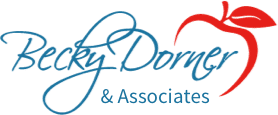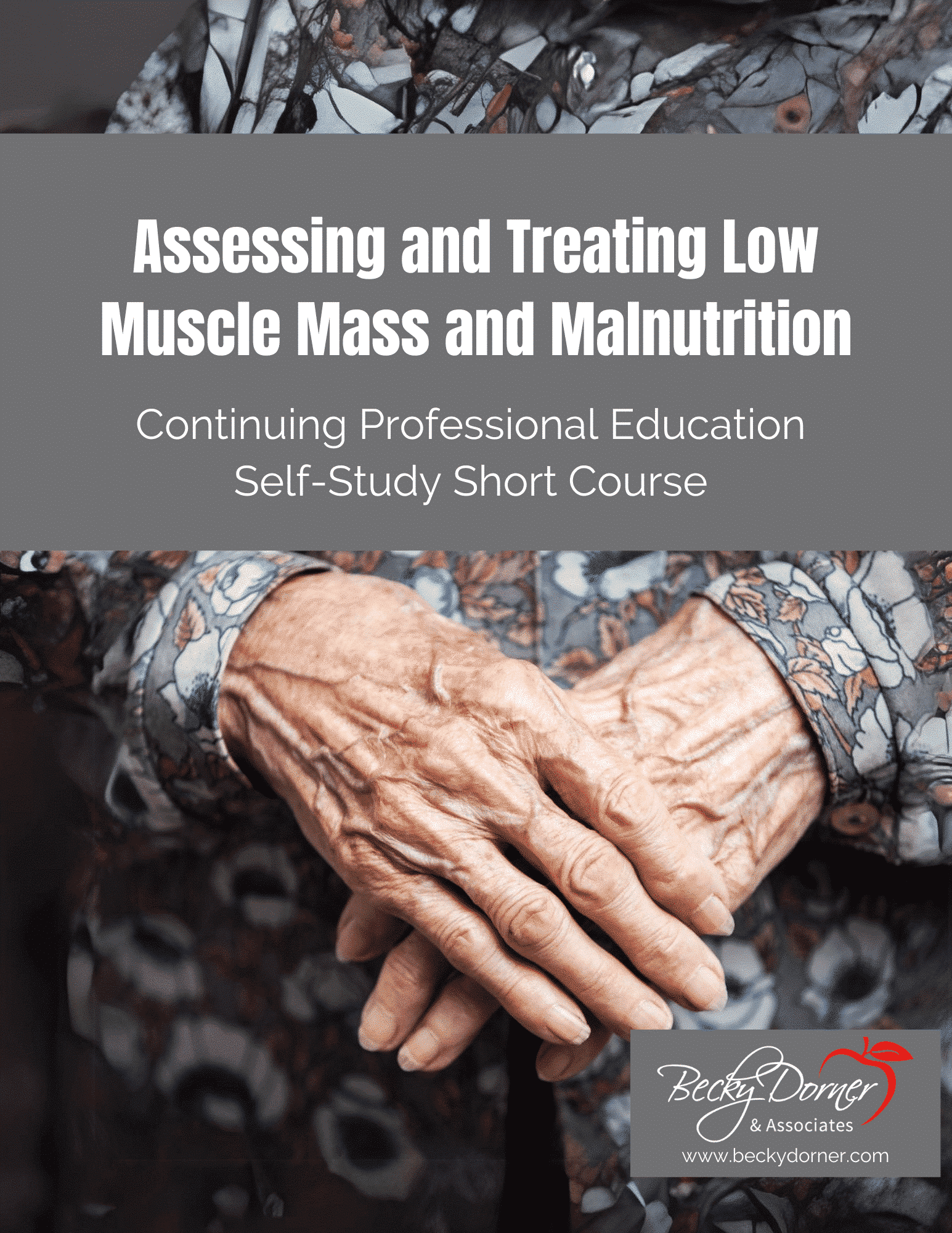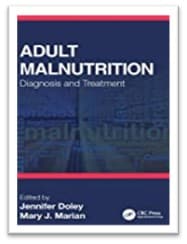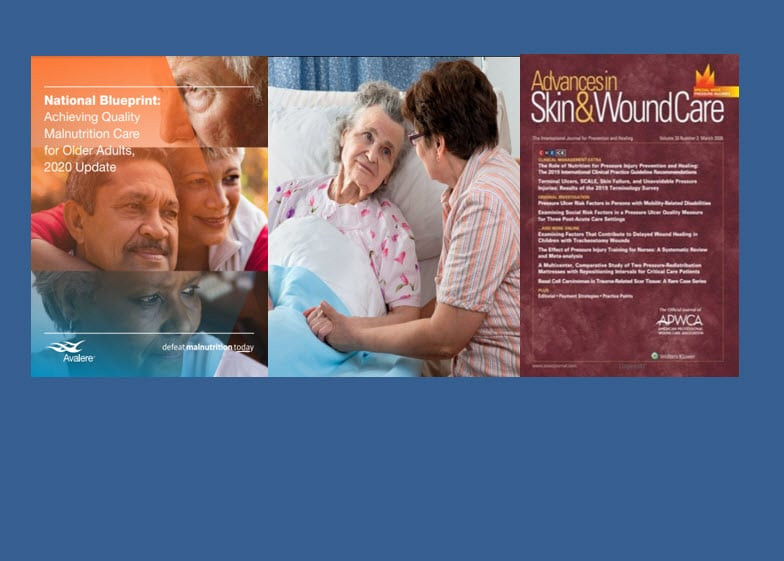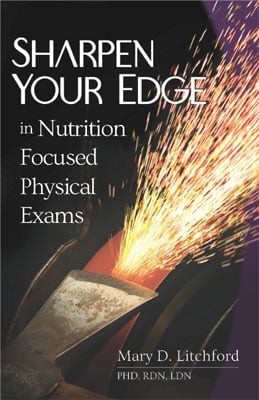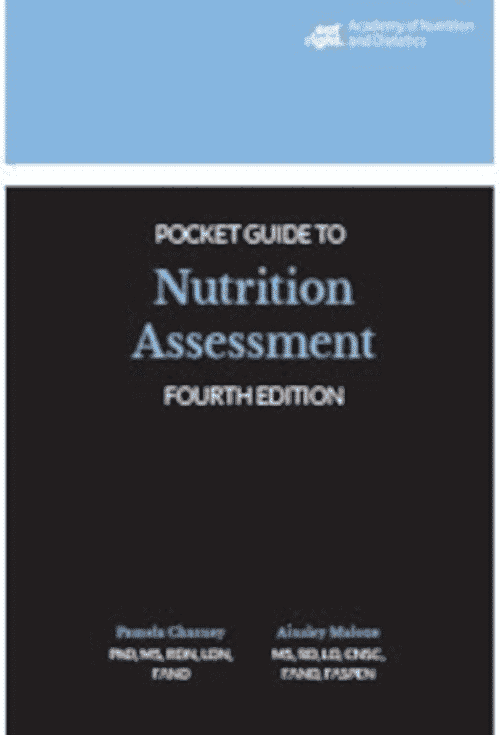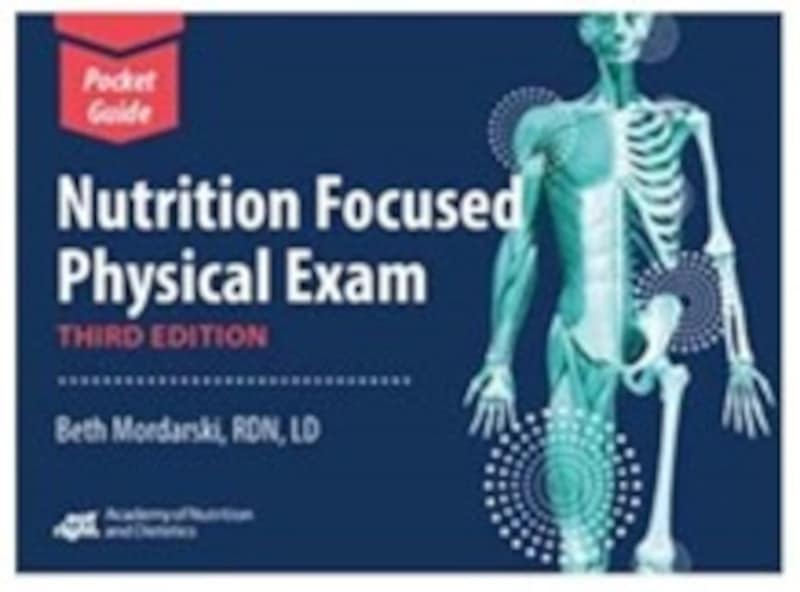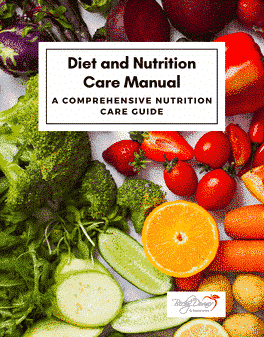Becky Dorner & Associates, Inc. exists to inspire excellence in malnutrition care through in-depth continuing education programs, current industry information and helpful resources. With decades of experience in the field of nutrition and dietetics, we understand the needs of healthcare professionals, particularly those who deal with the issue of malnutrition. We develop simple, ready-to-use publications on malnutrition to help you take your education and career to the next level.
We align with the Malnutrition Quality Improvement Initiative’s mission to help organizations improve malnutrition care and achieve better outcomes for patients. It is our hope that the CPE courses, webinars, articles and other resources below help you do just that.
Key Statistics on Malnutrition in the U.S.
%
Of patients in U.S. hospitals experience malnutrition. 1
%
Of hospitalized patients are diagnosed with malnutrition (many patients are left untreated without diagnosis). 1
%
Of malnourished patients are more likely to be readmitted within 30 days of hospital discharge. 2
%
Higher costs for malnourished hospitalized patients than those who are not malnourished. 3
%
Readmission risk reduction was achieved for malnourished patients with a nutrition care plan vs those without a care plan. 4
Sources:
1. Malnutrition in Hospitalized Adults. Agency for Healthcare Research and Quality. https://effectivehealthcare.ahrq.gov/products/malnutrition-hospitalized-adults/protocol.
2. Barrett ML, Bailey MK, Owens PL, Brown MH. Non-maternal and Non-neonatal Inpatient Stays in the United States Involving Malnutrition, 2016. August 30, 2018. U.S. Agency for Healthcare Research and Quality. Available at: https://www.hcup-us.ahrq.gov/reports/HCUPMalnutritionHospReport _083018.pdf.
3. Curtis LJ, Bernier P, Jeejeebhoy K, Allard J, Duerksen D, Gramlich L, Laporte M, Keller HH. Costs of hospital malnutrition. Clin Nutr. 2017;36(5):1391-1396.
4. Valladares AF, Kilgore KM, Partridge J, Sulo S, Kerr KW, McCauley S. How a Malnutrition Quality Improvement Initiative Furthers Malnutrition Measurement and Care: Results From a Hospital Learning Collaborative. JPEN J Parenter Enteral Nutr. 2021 Feb;45(2):366-371.
CPE Courses on Malnutrition
Webinars on Malnutrition

When Malnutrition Lives in a Larger Body: Effectively and Compassionately Treating Binge Eating Disorder
Binge Eating Disorder (BED) is the most common eating disorder in the United States – it is more prevalent than Anorexia Nervosa and Bulimia Nervosa combined.

Part 2: When Malnutrition Lives in a Larger Body: Effective & Compassionate Interventions for Treating BED
Join Amanda Mellowspring, MS, RD/N, CEDRD-S to discuss Binge Eating Disorder and cover effective treatment strategies and interventions focusing on behavior rather than weight.

Malnutrition…Sarcopenia…Dysphagia…Are you making the clinical connections?
Join award winning dietitian, Dr. Mary Litchford, PhD, RDN, LDN and learn how to advance your clinical practice!
Featured Blog Posts on Malnutrition

Malnutrition Diagnosis and the Value of an Experienced Registered Dietitian Nutritionist
Is your facility diagnosing malnutrition correctly and including documentation needed to support that diagnosis? This…Read More

Spotlight on Malnutrition Month & Malnutrition Awareness Week
Nutrition professionals play a crucial role in identifying and treating malnutrition, and it’s a condition…Read More

Which Nutrition Screening Tool Should I Use?
Nutrition screening is the process of identifying and referring to the registered dietitian nutritionist (RDN)…Read More

Identifying Malnutrition: Where Are We as a Profession?
Registered dietitian nutritionists (RDNs) are aware of the importance of identifying and treating malnutrition. Malnutrition…Read More
FAQs on Malnutrition
Get answers to nutrition professionals’ most frequently asked questions about malnutrition below!
MALNUTRITION
My administrator wants to capture malnutrition for reimbursement purposes using the patient-driven payment model (PDPM). She has asked me for guidelines to identify malnutrition. How should I respond?
When the patient driven payment model was unveiled by the Centers for Medicare and Medicaid Services (CMS), it placed malnutrition under the non-therapy ancillary case-mix component as a contributor to reimbursement for patient care. To obtain reimbursement based on malnutrition, it must be diagnosed by a provider. Unfortunately, CMS provided no specific guidelines on how to support that diagnosis, so it is up to each facility to use their discretion.
In our experience, some facilities use the Mini-Nutritional Assessment (MNA) or Subjective Global Assessment (SGA), both of which provide a score indicating at risk of or with malnutrition. Others use the ASPEN/Academy of Nutrition Guidelines or Global Leadership Initiative on Malnutrition (GLIM). It is important that both the RDN and provider support the diagnosis with documentation. As an RDN, at a minimum you should document if BMI is below normal, if the patient has a history of weight loss, if intake is poor, and/or if nutrition-focused physical exam or visual appearance is indicative of malnutrition.
I know that albumin is no longer recommended for the diagnosis of malnutrition, but I keep getting referrals from providers in my facility saying “Dietary consult due to low albumin.” Can you provide guidance on how to approach the providers about this?
We have found that many providers have been slow to accept that visceral proteins are no longer considered indicators of malnutrition. So it seems that it is up to you to educate them! If possible, a face-to-face chat about changes in the diagnostic criteria for malnutrition is in order. You should provide written evidence-based guidance that a low albumin level is related to underlying inflammation, not protein intake, which hopefully will solve the problem. There have been many journal articles on the subject in the past 2 decades that can be found using a pubmed.gov search. A recent and very convincing argument can be found in a 2020 ASPEN position paper titled “The Use of Visceral Proteins as Nutrition Markers: An ASPEN Position Paper: by Evans, Corkins, Malone, et al. It can be downloaded for free at The Use of Visceral Proteins as Nutrition Markers: An ASPEN Position Paper (wiley.com). Good luck!
I find that the ASPEN/Academy of Nutrition and Dietetics Guidelines for diagnosing malnutrition are time-consuming to implement. Is there a “quick and dirty” alternative that I can use?
The 2012 ASPEN/Academy Guidelines have been adopted by many health care organizations. While initially intimidating, they can easily be integrated into an acute or post-acute care setting with a little practice. A more recent method (2018) is the Global Leadership Initiative on Malnutrition (GLIM), which is similar to the ASPEN/Academy Guidelines. But if you are looking for something a little simpler, you might consider using the tried and true Mini Nutritional Assessment (MNA) or the Subject Global Assessment (SGA).
According to a 2021 review article in the journal Nutrition in Clinical Practice, both can be used to diagnose malnutrition. All four of these methods have overlap between the criteria used in malnutrition diagnosis (unplanned weight loss, inadequate energy intake, loss of muscle mass, and presence of disease severity). No matter what method you use, be sure to document findings like weight loss, muscle wasting and poor intake that can indicate malnutrition is present.
I have one nurse, a unit manager, in my facility who asks the provider to order oral nutritional supplements based on a low albumin level. I frequently suggest they be discontinued if the patient does not show signs of malnutrition and is eating well. How can I address this problem?
Although we are not certain, we suspect that some nursing schools are still teaching that a low albumin is an indicator of malnutrition, because many nurses, even younger ones, still focus on low albumin levels. Or perhaps some nurses rely on outdated information in their files. Regardless, it is important for you to have a conversation about the current school of thought, which is that a low albumin is an indicator of inflammation resulting from an acute or chronic condition, not an indicator of low protein intake. We have had success by providing inservice education to all staff nurses on the subject and by providing written papers such as the 2021 ASPEN Position paper titled “The Use of Visceral Proteins as Nutrition Markers: An ASPEN Position Paper. It can be downloaded for free here: The Use of Visceral Proteins as Nutrition Markers: An ASPEN Position Paper (wiley.com).
The Medical Director at my facility asked me about GLIM this week and I had never heard of it. What is GLIM?
The Global Leadership Initiative on Malnutrition (GLIM) was convened in January 2016 with a goal of building global consensus around core diagnostic criteria for malnutrition in adults in clinical settings. In a paper published in 2019 in the Journal of Cachexia, Sarcopenia and Muscle (DOI: 10.1016/j.clnu.2018.08.002), the group outlined proposed criteria selected for a malnutrition diagnosis.
The group identified five criteria for malnutrition: weight loss, low body mass index (BMI), reduced muscle mass, reduced food intake or assimilation and disease burden/inflammation and set criteria that would categorize malnutrition as mild, moderate or severe. GLIM is similar to the ASPEN/Academy of Nutrition and Dietetics Guidelines that are currently used in many health care settings.
The administrator in the skilled nursing facility I work in has decided to implement nutrition screening for every patient that is admitted to the facility. I am not sure this is necessary because I provide a comprehensive nutrition assessment for each of those patients. Do you have an opinion on this?
Nutrition screening can be an important tool to help skilled nursing facilities identify malnutrition in the first few days of admission. Under the Center for Medicare and Medicaid Service’s patient driven payment model (PDPM), a malnutrition diagnosis can increase reimbursement to a facility if it is documented by a provider shortly after admission.
A nutrition screening tool like the Mini-Nutrition Assessment can be (completed by a nurse or CNA upon admission) can help the provider support a diagnosis of malnutrition. A comprehensive nutrition assessment is still necessary to meet the standard of good nutrition care, but it may not always take place in a timely-enough manner to provide information to the provider quickly enough to meet PDPM guidelines. For that reason, nutrition screening on each patient is recommended. Your comprehensive assessment will support the diagnosis of malnutrition, and of course you should always follow through with interventions and monitoring and evaluation of a patient’s nutritional status.
I am struggling with how to determine what interventions my facility should provide when malnutrition is identified in patients who are not tube fed. Can you help me determine how to intervene to improve nutritional status?
Some facilities opt to implement step-by-step protocols for nutrition interventions, but we think it is important to remember that care should be patient-centered as much as possible. We believe in food first, especially for people who are eating well. For those individuals, large portions or fortified foods are a good first line of attack. If meal intake is not good, oral nutritional supplements (ONS) will probably be needed. Most facilities have a standard list of ONS that include 4 and/or 8-ounce shakes-type drinks, nutrition “shots” (2-3 ounce portions), fortified clear liquid beverages, and frozen desserts that are fortified. If possible, the patient and/or family should have a say in which interventions (including which flavor) are ordered, and this should be revisited periodically. While it is patient-friendly to provide a wide variety of supplements from different manufacturers, it is typically more cost-effective and less confusing for staff to select specific manufacturers and use them exclusively.
What is the Malnutrition Quality Improvement Initiative?
The Malnutrition Quality Improvement Initiative (MQii) was established in partnership with the Academy of Nutrition and Dietetics, Avalere Health and other stakeholders. The primary goal is to advance evidence-based, high-quality, patient-driven care for hospitalized older adults who are malnourished or at-risk for malnutrition. It has three major objectives:
- Support healthcare institutions in achieving malnutrition standards of care through use of an interdisciplinary, evidence-based malnutrition quality improvement toolkit and a set of malnutrition electronic clinical quality measures.
- Advance adoption of malnutrition best practices at healthcare institutions through a nationwide MQii
- Learning Collaborative with the goal of improving outcomes that are important to patients and clinicians.
- Improve nutrition risk identification and care as patients transition across care settings—for example, through integration into existing care transition pathways and accountable care models.
You can learn more from the Malnutrition Quality Improvement Initiative website.
A physician asked me about malnutrition in overweight or obese patients. Can you provide some talking points to help me discuss it with him?
The World Health Organization defines malnutrition as the “deficiencies, excesses, or imbalances in a person’s intake of energy and/or nutrients.” We typically think of malnutrition as “undernutrition”, which in adults often includes muscle wasting, low BMI, poor food intake and weight loss, but it can also be related to overnutrition, or intake of too many calories.
In fact, a large burden of malnutrition exists in the overweight and obese population, usually related to a high consumption of calorie-dense and nutrient-poor foods. It is indeed possible for people who are overweight or obese to have protein, vitamin and mineral deficiencies related to their diet. In some cases, obesity might mask the presence of malnutrition.
What is the Defeat Malnutrition Today initiative?
Defeat malnutrition today is a coalition of over 100 organizations and stakeholders
working to defeat older adult malnutrition. Their goal is to achieve the recognition of malnutrition as a key indicator and vital sign of older adult health risk.
Defeat Malnutrition Today works to achieve a greater focus on malnutrition screening and intervention through regulatory and/or legislative change across the nation’s health care system. More information can be found at the defeat malnutrition today website.
Learn more in our Diet and Nutrition Care Manual.
Free Resources on Malnutrition and More
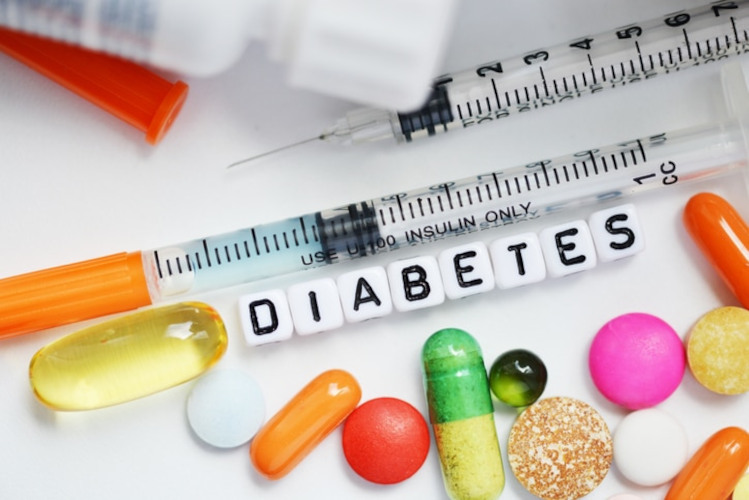
Blog
Check our blog regularly for new articles on diabetes and other nutrition care topics.

Email List
Subscribe to stay up-to-date on new products, sales, free resources and more!

Free CPEs
Access free CPE courses and webinars to take your career to the next leve
The Essentials for Every Nutrition Professional
Browse Resources by Topic
Did you know you can now browse courses, webinars and other resources on our website by topic (in addition to Malnutrition)? We will be adding more topics soon!

Cardiovascular Health

Diabetes

Dysphagia

Older Adult Nutrition
Request a Malnutrition Resource
Interested in learning more about malnutrition but don’t see the specific topic here? We’d love to get ideas for new resource creation! Submit the form below to tell us what we’re missing.
"*" indicates required fields
